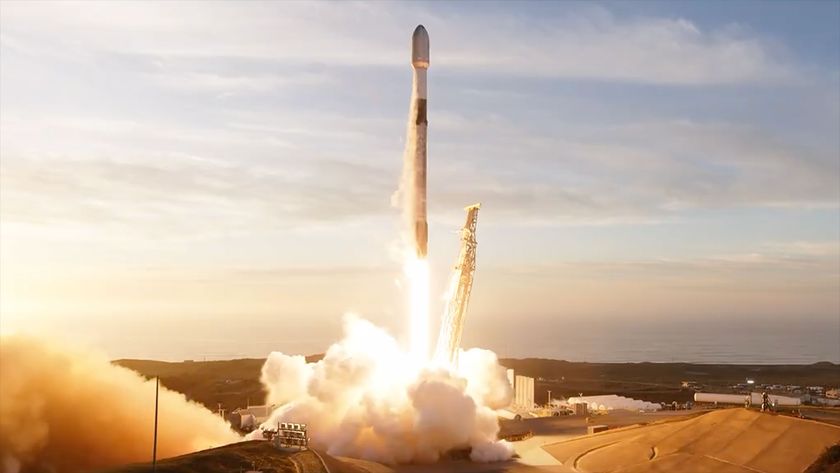Eavesdropping on ET Sooner Than We Think
SEATTLE -- OnWednesday, January 10, here at the American Astronomical Society Meeting, theorist Dr. Avi Loeb from Harvard Smithsonian Center forAstrophysics led a press conference on the search for ET. "Soon, we may beeavesdropping on signals from Galactic civilizations," said Loeb. "This is thefirst time in history that humans will be capable of finding a civilizationlike ours among the stars." Loeb asserts that the proposed search will find "leakage"from transmissions equivalent to our broadcast television or military radars.SETI Institute's Project Phoenix and UC Berkeley's SERENDIP have both had thetechnical capability to detect intentional signals--beamed at Earth--with theequivalent power to military radars. Loeb's search would expand the frequencyrange over which searches are conducted.
Loeb andhis co-author Matias Zaldarriaga (CfA) suggest looking for accidental leakagefrom an alien civilization. They point out that the new Mileura Wide-FieldArray's Low Frequency Demonstrator (MWA-LFD), which is designed to studyfrequencies of 80-300 Megahertz, will pick up the same frequencies used byEarth technologies. On Earth, military radars are the most powerful broadcastsources, followed by television and FM radio. If similar broadcast sourcesexist on other planets, facilities like MWA-LFD might detect them. A SETIprogram at the MWA-LFD would complement other SETI projects. It will observe alarger area of the sky over a longer period of time and in a differentfrequency range.
"TheMWA-LFD is a science instrument intended to study the distant, young universe,"explained Zaldarriaga. "But by piggybacking onto its normal observations, SETIresearchers could use it to look for E.T. civilizations." Loeb and Zaldarriagacalculate that by staring at the sky for a month, the MWA-LFD could detectEarth-like radio signals from a distance of up to 30 light-years, which wouldencompass approximately 1,000 stars. More powerful broadcasts could be detectedto even greater distances. Future observatories like the Square Kilometer Arraycould detect Earth-like broadcasts from 10 times farther away, which wouldencompass 100 million stars.
Dr. PeterBackus, Research Scientist at SETI Institute also spoke at the pressconference. He stated that the MDA-LFD represents a good example of the powerof the new generation of radio telescopes. Taking advantage of advances intechnology, these telescopes are more powerful and flexible than thetraditional, large radio telescopes. Using this same design model, "large N,small D" (a large number of small diameter dishes) the Allen Telescope Array(ATA) will ultimately have 350 dishes, each only 6 meters across. Thecombination of these dishes will have the equivalent sensitivity of the VeryLarge Array in New Mexico and the Green Bank Telescope in West Virginia. Usingprogrammable electronics, the signals from the 350 dishes can be combined toform up to 16 virtual antennas, each making independent observations. At thesame time, other electronics can image an area of the sky at two differentfrequencies. The ATA will expand the search to higher frequencies that have farless interference and background noise than the lower frequencies that will beobserved by the MWA-LFD.
Backusfeels that this proposed low-frequency search is a good first step in exploringthe lower frequencies for leakage or non-intentional signals. The unknownproperties of such extraterrestrial transmissions will continue to providechallenges for low frequency searches. He looks forward to the outcome of thisnew observing project with the MWA-LFD.
- All About SETI
- Listening for ET's Television
- Shadows and Silhouettes: Looking for Transits
- Images: Venus Transit Gallery
- Detecting Other Worlds: The Transit or 'Wink' Method
- Way-Out World: New Technique Finds Most Distant Planet Ever
- Mercury Transits Sun, Images on Web
Get the Space.com Newsletter
Breaking space news, the latest updates on rocket launches, skywatching events and more!
Join our Space Forums to keep talking space on the latest missions, night sky and more! And if you have a news tip, correction or comment, let us know at: community@space.com.

Edna DeVore is a science and astronomy educator and the former Director of Education and Public Outreach for the SETI Institute. She earned an undergraduate degree from the University of Pacific followed by a master's degree in instructional technology from San Jose State and a master's in astronomy from the University of Arizona. In 1992, Edna joined the SETI Institute, where she wrote features on space exploration, astrobiology and more, some of which appeared on Space.com. She was among the first principal investigators to propose projects to NASA's Office of Space Science and receive funding for educational programs. Edna went on to work on education and public outreach for NASA's Kepler space telescope and SOFIA flying telescope missions. Edna received numerous awards during her tenure at SETI, including NASA Honor Awards for her work on Kepler and SOFIA, and Aerospace Awareness Award for Women in Aerospace in 2005. Edna retired in 2013.
Most Popular




